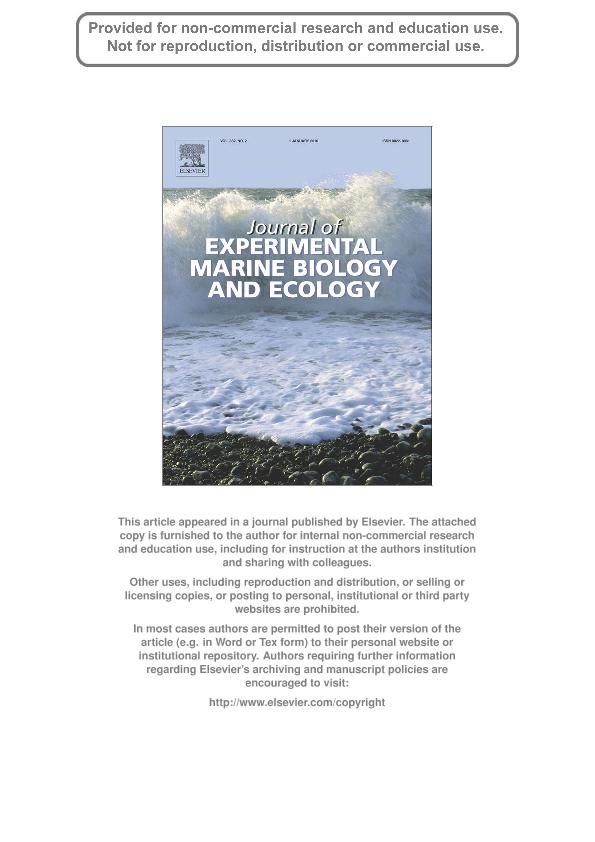Mostrar el registro sencillo del ítem
dc.contributor.author
Savoya, Veronica

dc.contributor.author
Schwindt, Evangelina

dc.date.available
2018-10-16T19:28:00Z
dc.date.issued
2010-01
dc.identifier.citation
Savoya, Veronica; Schwindt, Evangelina; Effect of the substratum in the recruitment and survival of the introduced barnacle Balanus glandula (Darwin 1854) in Patagonia, Argentina; Elsevier Science; Journal of Experimental Marine Biology and Ecology; 382; 2; 1-2010; 125-130
dc.identifier.issn
0022-0981
dc.identifier.uri
http://hdl.handle.net/11336/62468
dc.description.abstract
The barnacle Balanus glandula was introduced in Argentina in the 1970s, and today it dominates the high intertidal level in most Argentinean rocky shores. The aim of this work was to evaluate the effect of the type of substrata and intertidal height on a population of Balanus glandula by conducting field surveys and one-year field experiments in which we combined different substrata (hardness: hard and soft, and texture: smooth and rough) at two intertidal heights (mid and high). In natural populations, the highest density of adults and recruits occurred on soft-rough substratum and in the high intertidal. The different textures were important only on the soft substrata and high intertidal, and the density of barnacles of the soft-rough substrata was higher than soft and smooth ones. The most suitable experimental substratum was the soft-rough of the high intertidal, which had the highest recruitment, survival and final density of barnacles at the end of the experiment. In contrast, the hard and smooth of the high and middle intertidal were the least suitable in all cases. Although the recruitment of B. glandula occurred throughout the year, it was higher in the high intertidal, and it showed a recruitment peak in the winter and a second in the summer. While most studies on this barnacle investigated the effects of granite or other volcanic hard substrata, our study also focused on soft substrata. The effects of soft substrata are particularly important because soft sedimentary rocks characterise the southern Atlantic coast of South America and the presence of soft rocks appears to optimize the success of Balanus glandula.
dc.format
application/pdf
dc.language.iso
eng
dc.publisher
Elsevier Science

dc.rights
info:eu-repo/semantics/openAccess
dc.rights.uri
https://creativecommons.org/licenses/by-nc-sa/2.5/ar/
dc.subject
Balanus Glandula
dc.subject
Exotic Species
dc.subject
Recruitment
dc.subject
Rocky Shores
dc.subject.classification
Otras Ciencias Biológicas

dc.subject.classification
Ciencias Biológicas

dc.subject.classification
CIENCIAS NATURALES Y EXACTAS

dc.title
Effect of the substratum in the recruitment and survival of the introduced barnacle Balanus glandula (Darwin 1854) in Patagonia, Argentina
dc.type
info:eu-repo/semantics/article
dc.type
info:ar-repo/semantics/artículo
dc.type
info:eu-repo/semantics/publishedVersion
dc.date.updated
2018-10-12T18:04:23Z
dc.journal.volume
382
dc.journal.number
2
dc.journal.pagination
125-130
dc.journal.pais
Países Bajos

dc.journal.ciudad
Amsterdam
dc.description.fil
Fil: Savoya, Veronica. Consejo Nacional de Investigaciones Científicas y Técnicas. Centro Nacional Patagónico; Argentina
dc.description.fil
Fil: Schwindt, Evangelina. Consejo Nacional de Investigaciones Científicas y Técnicas. Centro Nacional Patagónico; Argentina
dc.journal.title
Journal of Experimental Marine Biology and Ecology

dc.relation.alternativeid
info:eu-repo/semantics/altIdentifier/doi/http://dx.doi.org/10.1016/j.jembe.2009.10.012
dc.relation.alternativeid
info:eu-repo/semantics/altIdentifier/url/https://www.sciencedirect.com/science/article/pii/S0022098109004481
Archivos asociados
